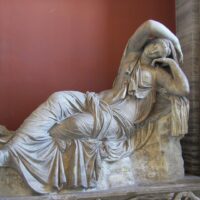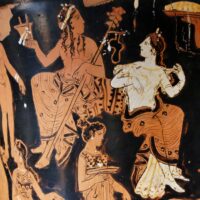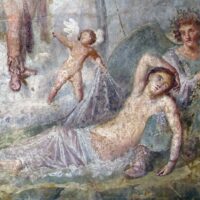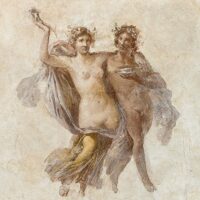Ariadne : The Guiding Thread
Listen
At a glance
| Description | |
|---|---|
| Origin | Mediterranean Mythology |
| Classification | Mortals |
| Family Members | Minos (Father), Pasiphaë (Mother), Phaedra, Androgeus, Deucalion, and the Minotaur (Siblings) |
| Region | Greece, Italy |
| Associated With | Royalty, Helpfulness |
Ariadne
Introduction
Ariadne, the princess of Crete, is one of the most enduring figures in Greek mythology, remembered for her connection to the myth of the Minotaur and her transformation from a mortal woman into a goddess. Her story combines themes of courage, betrayal, love, and divine salvation. Best known for aiding Theseus in navigating the labyrinth and slaying the Minotaur, Ariadne represents both the fragility of human devotion and the promise of divine immortality. Over time, her tale has been reinterpreted, evolving from myth to symbol, influencing art, literature, and modern thought. Ariadne’s presence continues to fascinate because her narrative embodies the complexities of loyalty, loss, and redemption.
Physical Traits
The ancient sources rarely describe Ariadne in detail, but her image has been shaped by art across centuries. Frescoes and mosaics often present her as a youthful, graceful woman with flowing hair and refined garments that emphasize her royal status. Renaissance artists, such as Titian, depicted her with expressive features, often caught between human vulnerability and divine destiny. Symbolically, she is sometimes shown holding a thread or wearing a radiant crown, each serving as an emblem of her mythic role. These recurring attributes highlight Ariadne not only as a figure of beauty but as one who embodies intelligence, resilience, and transformation.
Family
Ariadne’s family placed her at the heart of both mortal and divine lineage. She was the daughter of King Minos of Crete, a powerful ruler descended from Zeus and Europa, and Pasiphaë, daughter of Helios, the sun god. This dual heritage made Ariadne both a mortal princess and the granddaughter of a celestial deity. Her siblings included Phaedra, who later became tragically entangled with Theseus and Hippolytus, and Androgeus, whose death led to Athens being forced to send youths as tribute to Crete. Perhaps most striking is Ariadne’s connection to the Minotaur, born from Pasiphaë’s cursed union with a bull, making the monster her half-brother. This family background placed Ariadne at the crossroads of myth, where political power, divine curses, and tragic destinies converged.
Other names
The name Ariadne comes from the Cretan Greek elements “ari” meaning “most” and “adnos” meaning “holy,” translating as “the most holy.” This suggests that Ariadne may originally have been associated with sacred rituals or cult practices in Minoan Crete. Some scholars argue that her name points to pre-Greek origins, possibly reflecting her role as a vestige of an earlier Minoan goddess. In Roman mythology, she was identified with Libera, a fertility goddess linked to freedom and wine. Homer referred to her as “kalliplókamos,” or “lovely-haired,” a poetic epithet emphasizing her charm and beauty. Over time, variations of her name—Ariadna, Ariane, Ariana—have been used across cultures, ensuring her survival in both linguistic and literary traditions.
Powers and Abilities
Though not divine at birth, Ariadne’s actions display remarkable qualities that elevate her to mythic stature. Her most famous contribution is providing Theseus with a ball of thread, enabling him to trace his path through the labyrinth and defeat the Minotaur. This act demonstrates her foresight, intelligence, and resourcefulness, qualities often ascribed to gods rather than mortals. After Theseus abandoned her on the island of Naxos, she was discovered by Dionysus, who took her as his consort and granted her immortality. Ariadne thus became associated with fertility, rebirth, and ecstatic ritual, reflecting her connection to Dionysian mysteries. Myth also tells that her jeweled crown was cast into the heavens by Dionysus, becoming the constellation Corona Borealis, a celestial reminder of her transformation. This blend of cleverness, resilience, and eventual divine status cements Ariadne as a symbol of guidance and renewal.
Modern Day Influence
Ariadne’s legacy extends far beyond antiquity, shaping literature, art, philosophy, and popular culture. In classical literature, Catullus’s Carmen 64 portrays her as a tragic heroine abandoned by Theseus, setting the tone for later interpretations that emphasize her emotional depth. Modern authors, including Jennifer Saint in her novel Ariadne, revisit her story from a feminist perspective, giving her voice and agency where ancient texts often silenced her. The enduring metaphor of “Ariadne’s thread” has been adopted in psychology, philosophy, and problem-solving theory to describe a guiding principle through complexity.
In art, her image became a favorite subject during the Renaissance and Baroque periods. Titian’s Bacchus and Ariadne remains one of the most celebrated depictions, capturing the moment of her discovery by Dionysus. Later, Giorgio de Chirico’s haunting portrayals of a sleeping Ariadne influenced Surrealist painters such as Salvador Dalí and René Magritte, who found in her myth themes of abandonment and transformation. Sculptures of the reclining Ariadne, particularly the celebrated Roman copy in the Vatican Museums, became central to European art history and inspired countless later works.
Ariadne’s story also entered music and performance. Richard Strauss’s opera Ariadne auf Naxos explores her abandonment and transcendence, blending myth with modern theatrical experimentation. Ballets and stage performances continue to reinterpret her tale as one of resilience and renewal. Even in modern cinema, echoes of Ariadne’s myth can be found—most notably in Christopher Nolan’s Inception, where the character Ariadne, an architect of dream worlds, symbolizes guidance through complexity, mirroring the original myth.
Her influence extends into popular culture as well. She has appeared in novels, television series, and even songs, each reimagining her role for contemporary audiences. Beyond entertainment, her symbolism survives in rituals and festivals, particularly in the Mediterranean world, where she was once celebrated as a goddess of fertility and transition. The constellation Corona Borealis still serves as a celestial marker of her presence, keeping her myth alive in the night sky.
Related Images
Source
Wikipedia contributors. (2023). Ariadne. In Wikipedia, The Free Encyclopedia. Retrieved from https://en.wikipedia.org/wiki/Ariadne
Smith, W. (Ed.). (1870). A Dictionary of Greek and Roman Biography and Mythology. Retrieved from https://bible-history.com/linkpage/ariadne-in-greek-and-roman-biography-and-mythology
Theoi Project. (2023). Ariadne – Greek Goddess Wife of Dionysus (Roman Libera). Retrieved from https://www.theoi.com/Georgikos/Ariadne.html
Ariadne | Myth & Summary – Britannica. (2025). https://www.britannica.com/topic/Ariadne-Greek-mythology
Contributors to Riordan Wiki. (2024). Ariadne | Riordan Wiki – Fandom. https://riordan.fandom.com/wiki/Ariadne
Avi Kapach. (2023). Ariadne – Mythopedia. https://mythopedia.com/topics/ariadne/
Ariadne in Greek Mythology. (n.d.). https://www.greeklegendsandmyths.com/ariadne.html
Frequently Asked Questions
What is lorem Ipsum?
I am text block. Click edit button to change this text. Lorem ipsum dolor sit amet, consectetur adipiscing elit. Ut elit tellus, luctus nec ullamcorper mattis, pulvinar dapibus leo.
What is lorem Ipsum?
I am text block. Click edit button to change this text. Lorem ipsum dolor sit amet, consectetur adipiscing elit. Ut elit tellus, luctus nec ullamcorper mattis, pulvinar dapibus leo.
What is lorem Ipsum?
I am text block. Click edit button to change this text. Lorem ipsum dolor sit amet, consectetur adipiscing elit. Ut elit tellus, luctus nec ullamcorper mattis, pulvinar dapibus leo.
What is lorem Ipsum?
I am text block. Click edit button to change this text. Lorem ipsum dolor sit amet, consectetur adipiscing elit. Ut elit tellus, luctus nec ullamcorper mattis, pulvinar dapibus leo.
What is lorem Ipsum?
I am text block. Click edit button to change this text. Lorem ipsum dolor sit amet, consectetur adipiscing elit. Ut elit tellus, luctus nec ullamcorper mattis, pulvinar dapibus leo.











